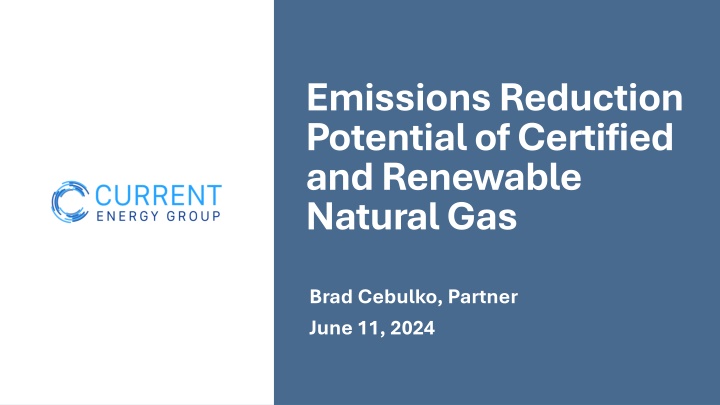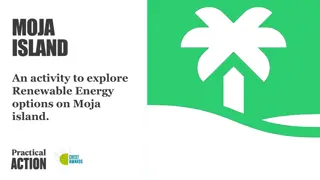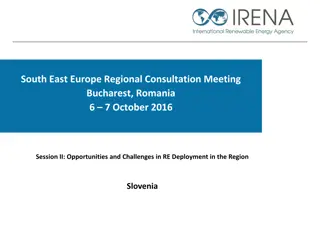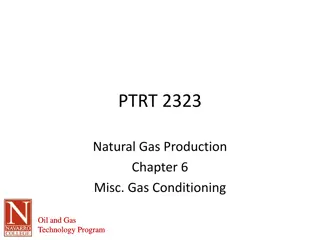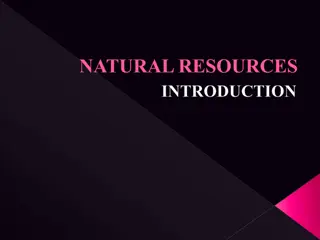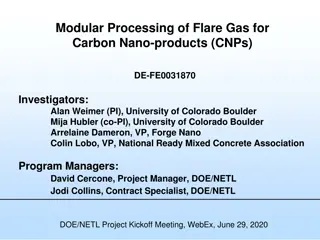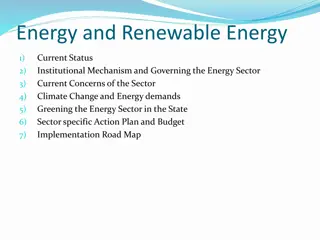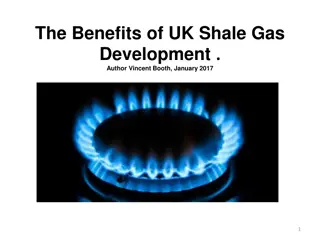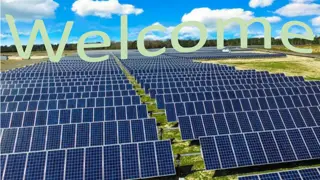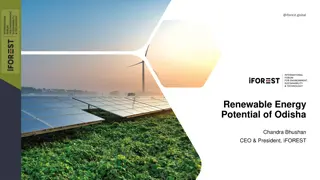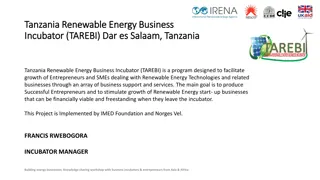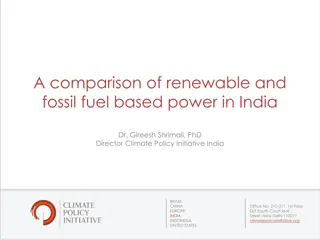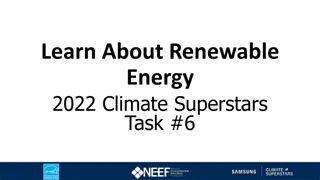Challenges and Potential of Certified and Renewable Natural Gas
Limited potential for decarbonization through compressed natural gas due to challenges in measuring and verifying emissions reductions. Renewable natural gas also faces technical and economic limitations. Synthetic methane and thermal gasification technologies are not widely available or cost-competitive, requiring multiple conditions to be met for feasibility.
Download Presentation

Please find below an Image/Link to download the presentation.
The content on the website is provided AS IS for your information and personal use only. It may not be sold, licensed, or shared on other websites without obtaining consent from the author.If you encounter any issues during the download, it is possible that the publisher has removed the file from their server.
You are allowed to download the files provided on this website for personal or commercial use, subject to the condition that they are used lawfully. All files are the property of their respective owners.
The content on the website is provided AS IS for your information and personal use only. It may not be sold, licensed, or shared on other websites without obtaining consent from the author.
E N D
Presentation Transcript
Emissions Reduction Potential of Certified and Renewable Natural Gas Brad Cebulko, Partner June 11, 2024
Emissions from all GHG in System and Combustion (2022 CO2Eq.) There is limited potential to decarbonize through CNG 5% 2% 2% 1% 1% 4% 27% 34% 10% Upstream emissions are a small proportion of natural gas wmissions 14% Exploration Transmission and Storage Transportation Commercial Combustion Production Distribution Electric Power Industrial Combustion Processing Post-Meter Residential Combustion Source: EPA Inventory of U.S. Greenhouse Gas Emissions and Sinks: 1990-2022
It is difficult to measure and verify CNG emissions reductions There are numerous bodies that provide certification, but no single industry-wide standard, scope, or framework Each entity has own quantification and verification method. Project Canary Trustwell, Equitable Origin EO100, MiQ, GTI Vertias Scope of emissions varies by entity (Scope 1, 1 & 2, or 1 3) as does certification eligibility time frame (1 3 years). There is risk for cherry-picking Most certificates are for individual wells rather than the entire company gas production. There is an incentive for companies to only certify their top performing wells. Unclear how the certification process will overlap with new EPA Standards It appears likely that 3rdparties will need to adjust their standards and grading mechanisms to maintain their role in promoting exceptional environmental practices beyond the new regulatory baseline.
Renewable natural gas has limited technical and economic potential Source: NRDC, Renewable Gas A Pipe Dream or Climate Solution? June 15, 2020. ICF Renewable Sources of Natural Gas: Supply and Emissions Reduction Assessment An American Gas Foundation Study Prepared by ICF. December 2019.
Synthetic methane and thermal gasification are not yet commercially available Synthetic methane/Power-to-Gas (15 18% of potential) is not broadly commercially available nor cost-competitive Several assumptions need to fall into place to be cost- competitive Sufficient excess renewable energy to enable green hydrogen Green hydrogen production becomes cost competitive Carbon capture becomes cost competitive Methanization process becomes cost competitive Electricity prices are low Thermal Gasification (25 38% of potential) is not broadly commercially available nor cost-competitive Gasification process typically yields a residual tar, which can foul downstream equipment Efficiency is around 60% - 65% Relatively few pilot projects
90% of RNG in transmission system is used for transportation fuel Source: Renewable Natural Gas Coalition, Economic Analysis of the US Renewable Natural Gas Industry December 2022.
What Questions Should a Consumer Advocate Ask? What are the objectives of the program? 10%, 50%, Net-Zero, 100%? Are emissions reductions voluntary or involuntary? Is participation voluntary or involuntary? Are the reductions real and is the program scalable? Is the utility using lifecycle emissions or combustion emissions accounting framework? Important for RNG and CNG. Are upstream emissions included in the utility emissions baseline? Is the verification source reputable and using best practices? If using MiQ, what grade level is permissible? What are expectations of emissions reductions in the near- and long-term? Will competition restrict availability of the resource? What are the near- and long-term costs and price risks? What are the lost opportunities (opportunity cost)? How does the cost of emissions reduction compare to alternatives (i.e., $/metric ton of CO2e) How will competition from other industries impact short- and long-term prices? Is the utility showing you production costs or market prices? Are the costs volatile? What are the risks of stranded assets? How is the gas utility marketing and communicating the program s emissions reductions to customers?
Contact Information bcebulko@currentenergy.group (317) 519-3165 Brad Cebulko, Partner
